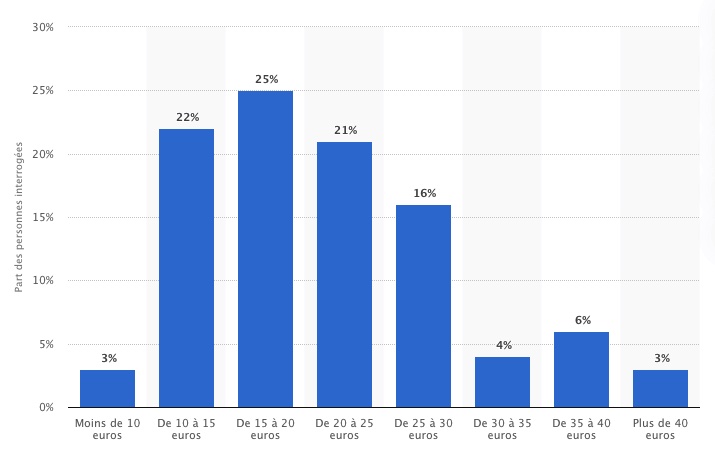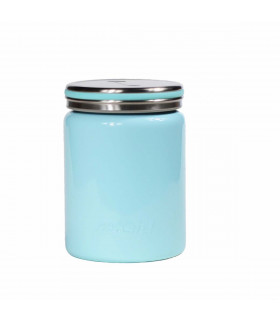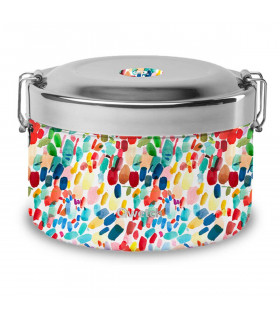Solutions to make meal delivery zero waste
Zero waste home meal delivery is rapidly becoming the norm. Plastic trays, cardboard packaging and plastic bottles are in the french government's target for the amount of waste they generate. According to the Ministry of Ecological and Solidarity Transition in France the number of meals delivered in France in 2018 exceeds 200 million. A constantly growing figure which, at this rate, is resulting in a real ecological disaster and unprecedented household waste.
It becomes all the more important to find solutions to remedy this mass of single-use packaging because waste management is becoming impossible. Waste treatment is a real environmental issue, knowing that Europe exports thousands of containers with our waste for recycling to Asia and Africa.
Brune Poirson announced it on July 1st, 2020, demanding proposals within 3 months to allow meal deliveries to go entirely zero waste. When you know the amount of meals, the actors to include and the powerful restaurant union, it's an ambitious mission to say the least. What to analyze, how to do it, what concrete solutions should be put in place. Let's take the time to dig deeper into the meal delivery figures to more effectively propose solutions to make the delivery of zero waste meals and avoid the current packaging waste.
Meal deliveries in figures
In order to better understand the phenomenon of meal delivery we need to arm ourselves with several figures. To find out the number of packages we're talking about, let's highlight the average amount of an order versus the average price of a dish. Dividing these two amounts will tell us the average number of meals ordered for each order.
Following a quantitative study carried out by Creatests in 2017 on the amount of orders for dishes in delivery, it turns out that an average order per meal is € 26.10.

In comparison, the site numbéo (collaborative site for average price data in the world) tells us that the average price of a dish ordered in a standard restaurant in France is € 13. These data being collaborative, and for the sake of conscience, we will add 15% to this price so as to not underestimate the amount of packages per order.
Taking these two pieces of information, we come to understand that on average one ordered delivered meal is intended for 1.75 people (€ 26.1 / (13 * 1.75)). This multiplication is to be applied to the number of orders made, to find out the number of packages concerned. A powerful indicator that reveals that meal deliveries represent at least 350 million single use packages per year in France (It is probably more in the UK as deliveries and online are far more developped). Knowing that this amount is constantly growing, the tonnage of avoidable waste puts additional pressure on our natural resources. Household waste is overflowing and imposing a zero waste approach to reduce the amount of waste is inevitable.
Kantar made a study in 2019 with numerous indicators :
- 29,2% of households order meal deliveries at least once a year
- 6% of households use a delivery platform to have a meal delivered
- Pizza is the most popular dish (26%) ahead of Asian and fastfood dishes/li>
- 49% of clients are less than 35 years old
- 80% are clients from cities of more than 200.000 inhabitants
Each type of dish delivered has its own problem
Each type of meal has its own packaging issue. For a pizza, we do not use the same type of packaging as a sushi dish, which will be different from a kebab. As a result, it becomes important to provide each sector with a zero waste solution specific to its dishes to be fully eco-responsible and to prevent our ordered meal waste from ending up in the trash.
1. Pizza
Pizza is the most popular meal to order. Orienting pizzas to zero waste packaging would solve a big part of the equation. The pizzas are always packaged in non-recyclable square cardboard boxes. For pizzerias a double problem arises to achieve zero waste.
Although cardboard is compostable, it is not reusable and therefore turns into waste. In addition, a pizza packaging box is systematically soiled with grease stains and is therefore no longer valuable. Another problem is that the vast majority of pizza boxes contain perfluorinated compounds (PFCs). Accused of having endocrine disrupting effects, they are added by manufacturers to make packaging waterproof and greaseproof, but above all resistant to heat. In short, it is completely impossible to continue with the packaging used, if we want to achieve zero waste in meal delivery.
2. Oriental dishes (sushi, Chinese, Indian cuisine, poké bowl, etc.)
One in six meals is of the oriental type and is almost always served in a plastic tray or in expanded polystyrene (EPS). Cardboard packaging is a very small minority and all have a disposable plastic cover. The entire packaging is to be questioned. These plastics only have a lifespan of less than an hour for degradation of more than 400 years, not to mention the soil pollution they cause. In addition, the health episode of 2020 means that the packaging is also coated with additional plastic. These single-use plastics must be banned and replaced with reusable packaging.
Fastfood
Although this represents only a small portion of the meals delivered (approximately 1 in 20 meals), take out orders at these restaurants directly should not be neglected. Their packaging is made of thin cardboard, paper and plastic (for salad dressings) and their cardboard cups are printed with a light sealing plastic film. These chains have the advantage of being structured and that a decision of the head office will be imposed on all restaurants at once (proof of the plastic straw which has disappeared in favor of a cardboard lid with opening for drinking his drink). Finding the right zero waste packaging formula will indeed have a strong impact, also on all take-out meals and those eaten on the premises.
For meals taken on site, sorting in restaurants should be imposed. This would make it possible to better recycle what can be recycled and would participate in the prevention of waste which would inevitably end up in waste reception centers.
4. Kebabs, Paninis and Sandwichs
Kebabs, fries and sometimes paninis are packed in EPS (expanded polystyrene), where generally the sandwiches are wrapped in a paper bag like a baguette. Expanded polystyrenes are a real scourge for the environment because they systematically arrive in the oceans where fish confuse them with food. This ends up killing them for obstructing their stomachs. The alternative to be found must be radical because they no longer have their place in a world which respects life.
5. Hot drinks and soups
As for other drinks, here we find a cardboard packaging covered with a plastic film to seal it. In addition, the cover is plastic, not cardboard. This is to prevent the packaging from absorbing the liquid and to ensure that it does not spill during transport.
Having seen all the types of packaging, it becomes clearer as to the solutions to have be provided. It should be noted that restaurateurs and points of sale should be invited to the changes that need to be made, because it is above all they who will be impacted.
Solutions for zero waste meal deliveries between minimalism and large-scale deposit!
By grouping the different information together, we see that the actors who will be impacted are fragmented. Each point of sale will have to adapt its packaging and packaging method. Green waste is not an option given the quantity, we must give preference to packaging completely. How? 'Or' What ? In our opinion, here are the most effective solutions in terms of zero waste meal delivery:
How to make cutlery in meal delivery zero waste
Delivery applications already offer the option of being able to refuse cutlery when ordering. However, we propose to go further and make them pay off. A minimum of 1 € to buy cutlery should be set up. This increases the bill by about 5% and could be enough of a deterrent for everyone to get into the habit of using their own cutlery. A substantial gain in wood, bamboo and paper!
How to turn beverage packaging into zero waste
As the world's leading plastic pollutant, plastic bottles must be removed from orders and no longer be delivered. We suggest that drinks on delivery be packaged in glass only and that they be returnable. The customer should be able to return the bottles to any restaurant and receive a credit or refund in cash or on the app directly. Otherwise, if he wants to sort and throw it away, the glass recycling industry is very well structured in France, this would avoid a large number of plastic bottles in the trash.
Remove paper towels
Paper towels are a negligible part of all waste but remain colossal in quantity. Having your own handkerchief is not yet an established habit, although it deserves to exist. We are proposing to make the napkin optional in applications and require all napkins to be made from recycled paper and consist of paper only.
Hot and cold take-out packaging should be reused
To achieve azero waste goal in meal packaging, there is no choice but to use fully reusable packaging. A deposit system should see the light of day. With each purchase, the packaging is paid for, then once returned to the point of sale, the customer retrieves his deposit in the form of a code for the application or in cash directly. The difference lies in the treatment and cleaning of the packaging, which will necessarily add to the price of the meal.
The meal packaging deposit is not new, but is still far from reaching its potential. Creating the recovery network is a lot of work to put in place, but will be beneficial for other sectors. Especially since the ecological and economic benefits will be there. A bonus / penalty system to boost points of sale could be put in place to support physical points of sale when packaging is harvested. Restaurants that do not have points of sale (such as dark kitchens) could not receive reusable packaging from customers. They would therefore not be able to reuse them directly after cleaning them, but in addition would have to have them delivered.
Quite a lot of management to put in place, but very far from impossible, as this already partially exists with companies like GreenGo Store. Reusable packaging recovery terminals could, for example, be installed in the very many convenience stores and supermarkets to facilitate collection, cleaning and redistribution afterwards.
Can we make meal delivery zero waste?
Imposing zero waste on delivery meals is possible. From our point of view, it is even an obligation. The meals delivered mainly concern dense areas in cities. With ever faster lifestyles, where the lack of time to cook is increasing, the phenomenon of meal delivery will continue to grow. The waste generated will continue to add to an already dire environmental bill. The solutions to be implemented are not complicated and already exist. The complexity is to change dimension. The deposit on zero waste meal packaging concerns only a small part of the players today. Going from a handful of equipped restaurants to the whole of France is a high challenge. However, this could make it possible to create a real sustainable and ecological sector from which we will all benefit.
To be a pioneer at the country level in the delivery of meals in zero waste would not only be exciting but would provide substantial positive economic benefits. France is not the only country where the delivery of meals is growing and providing a global and industrial zero waste solution for the delivery of meals would be a strong signal for the success of the conservation of our planet.
What about you, what do you think?








